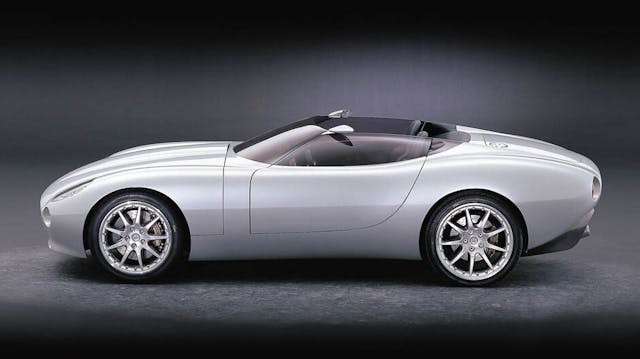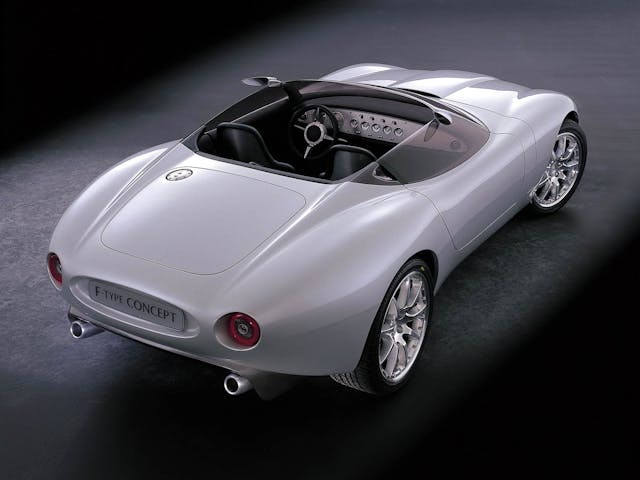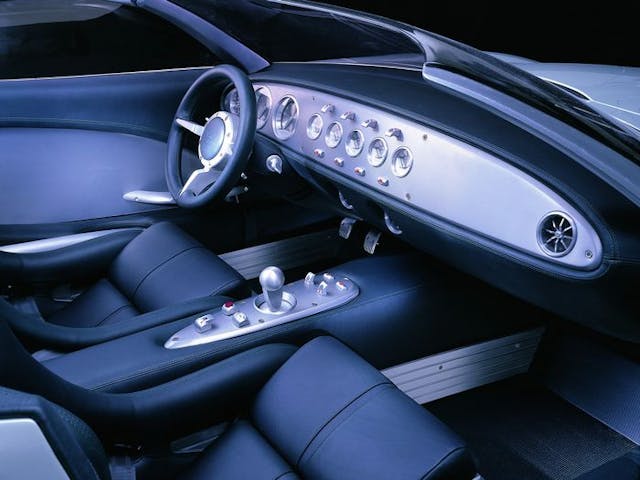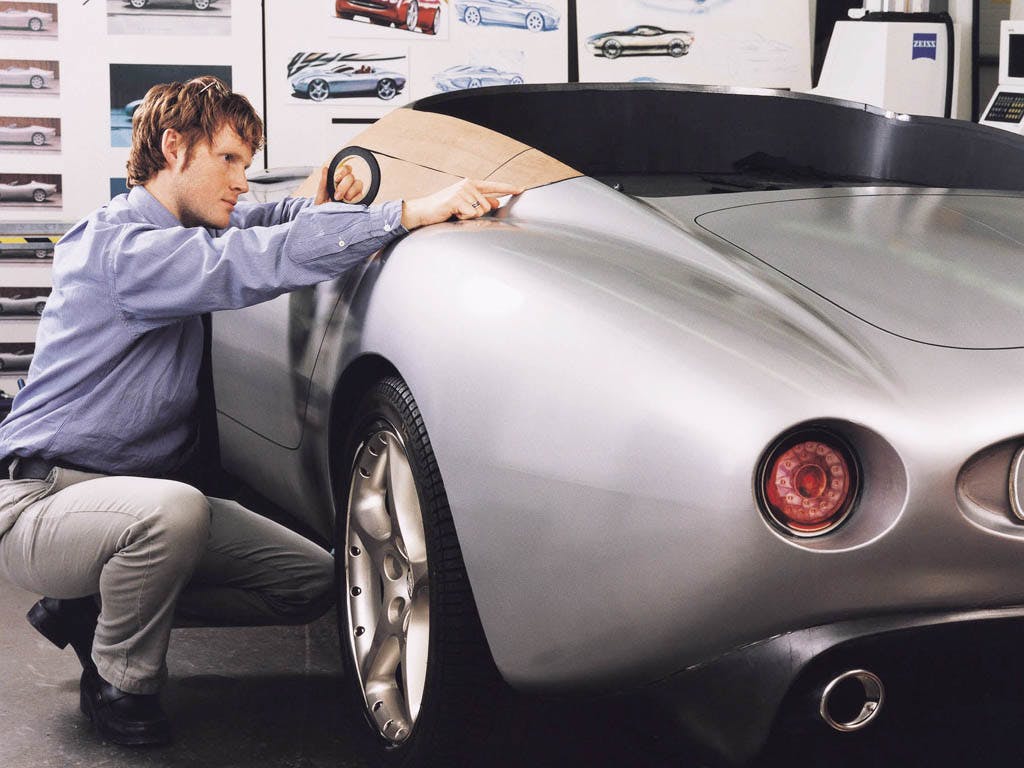In 2002, Ford killed Jaguar’s mid-engine roadster, the X600
“The overwhelmingly positive reaction across the globe to last year’s concept has convinced Jaguar to build the F-Type roadster.” That emphatic statement came from the lips of one Dr. Wolfgang Reitzle, then Chairman of Ford’s Premier Automotive Group, at the Los Angeles Motor Show in 2001. A year later, the F-Type program had been canned.
Before we find out why, let’s clear up any potential confusion. An F-Type did appear in production form many years later, but that was a very different car, based on a very different concept (the 2011 C-X16, to be precise). What we’re talking about here was an achingly beautiful show car from 2000, created under the watch of Geoff Lawson, Jaguar design director. It so wowed customers that a claimed 50,000 placed orders for its road-going version.
So how did that 2000 concept, which came so close to being a production reality, end up consigned to the great cupboard of declined proposals? Well, it certainly wasn’t through any lack of will. Jaguar had already attempted a modern take on the E-Type with the XJ 41/42 coupe and drophead concepts in the ’80s; by then, it was clear that the XJ-S would never make the cut. But when Ford bought Jaguar in 1989, it decided that a by-then rather bloated sports car was not a priority in its brave new world.
Nine years later, though, that world had changed. 1998 brought with it a raft of new and exciting sports cars (step forward Porsche Boxster, BMW Z3, Audi TT), all of which offered stylish entry points to their respective brands. Browns Lane needed a piece of the action, too, and this time its corporate parent was on Jaguar’s side.
Jaguar’s lead designer, Keith Helfet, had already created a one-off concept known as the XK180, using a cut-down XK8 platform. But while the 180 was only for show, its design signaled the possibility of a smaller, more affordable Jaguar sports car, and perhaps finally a worthy successor to the E-Type.
Under Lawson’s auspices, Helfet along with designers Adam Hatton and Pasi Pennanen started work on a knock-’em-dead concept that was to be known as the F-Type. Alas, this was to be Lawson’s final project; he died in June 1999. Helfet, Hatton, and Pennanen continued to develop the concept, but one can only imagine what a blow to the team Lawson’s passing must have been.

The F-Type was a fitting tribute. Taking some cues from the XK180, the concept stunned press and public alike when it was finally unveiled at the Detroit Auto Show in January 2000. Proportionally perfect, its sleek, roofless body blended just the right level of retro with enough modernity to carry it into the new millennia. Pure and unfussy, the F-Type was shorn of all unnecessary addenda, other than a modest rear diffuser. Inside, a spartan but exotic aluminum dash sported seven circular dials, with all switchgear—even the gear lever—formed from the same metal, too.
At 162 inches, it was three feet shorter than the incumbent XKR, with, Jaguar claimed, an equal weight distribution front to rear. Power was to come from Jaguar’s 240-hp AJV6, with the option of 300 hp from a supercharged version of the same engine, delivered to the rear wheels through either a manual or automatic ‘box.
It was a dream concept, and one that Ford’s management wanted to productionize—hence Reitzler’s bold words in 2001. But Ian Callum, who had replaced Lawson, saw a big challenge ahead: The F-Type was a pure show car. It didn’t use an existing platform, so some of its more distinctive elements, like the cut-down front glass and hood height, were pure fantasy, never designed to meet production regulations.

Callum’s solution was pragmatic but radical: put the engine in the middle. Development of the car, dubbed X600, started soon after the Detroit show, with a target time of three years to production launch. Internal marketing documents described the car as “a revolutionary and sexy Jaguar roadster,” with ‘uncompromising performance and handling that takes your breath away.’ The Whitley engineering team had even started real-world testing using Honda NSX “mules” fitted with Jaguar-designed suspension to validate chassis dynamics. In other words, the X600 was well on its way to being a car you could actually buy.

And then it wasn’t. As with the XJ 41/42 13 years before, Ford’s management once again saw greater priorities ahead, such as rapid development of then-fashionable diesel engine technology. So the thought of ploughing untold millions into a low-volume, aluminum-bodied two-seat sports car which needed a completely bespoke new platform looked like a bad idea. In 2002, Ford drew a line under the program, and X600 was no more. Perhaps that reimagined E-Type will always elude us.
***
Check out the Hagerty Media homepage so you don’t miss a single story, or better yet, bookmark it. To get our best stories delivered right to your inbox, subscribe to our newsletters.





I remember seeing the F Type in person at a show and immediately thinking “do all 3 of my kids really need to go to college?” It was truly a stunner and one that got away.
Cars like these are cool but in production most have to be changed to be practical or killed as they just don’t work.
The greatest damage was Ford put too much Ford into Jag and not enough Jag.
100% truth. Ford bought Jag never realizing that they needed to make low-volume unique cars, and that nobody wanted a (Ford) parts-bin, moderate-volume Jag. I half think that the Ford purchase was with the intention of killing Jag but keeping their areas of unique expertise and design cues, if so, it thankfully didn’t happen.
Yes, the article pointed that out. Concept car vs. show-ready can often be a leap too big to overcome.
Ironically, though, the amount of Ford put into Jag was also what saved it as a brand. There was plenty wrong with Jaguar, and while it didn’t emerge from Ford ownership in perfect shape, many fundamental issues had been substantially improved. Put another way, one may not think Ford is all that great, but Jaguar was so much worse that getting up to Ford standards was a huge leap forward.
It could have been an interesting idea but I do wonder how the execution would have been if it had been produced. The Ford era was very mixed results.
The current Jaguar F Type will never be excepted as a true successor to the original E Type. Never a more beautiful car has ever been produced!
So the X600 never made it to the styling stage? That’s unfortunate as Jag has had some stunning mid-engine cars.
As far as the eventual production F-type goes, I rather like it. It may not be “The World’s Most Beautiful Car”, but it is certainly handsome and unmistakably a Jag.
Ford made a big mistake, this would have been an iconic Jag marque.